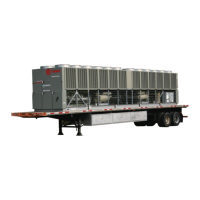97 RTAC-SVX002A-EN
IX-Unit Start-Up Procedures
The response of the EasyView Display is
also depicted on the time line.
NOTE: Unless the CH530 TechView
and building automation system are
controlling the chilled water pump, the
manual unit start sequence is as follows.
Operator actions are noted.
CAUTION
Compressor Damage!
Ensure that the compressor and oil
separator heaters have been operat-
ing for a minimum of 24 hours before
starting. Failure to do so may result in
equipment damage.
General
If the pre-start checkout, has been
completed, the unit is ready to start.
1. Press the STOP key on the CH530.
2. As necessary, adjust the setpoint val-
ues in the CH530 menus using Tech-
View.
3. Close the fused-disconnect switch
for the chilled water pump. Energize the
pump(s) to start water circulation.
4. Check the service valves on the dis-
charge line, suction line, oil line and
liquid line for each circuit. These valves
must be open (backseated) before start-
ing the compressors.
CAUTION
Compressor Damage!
Catastrophic damage to the compres-
sor will occur if the oil line shut off
valve or the isolation valves are left
closed on unit start-up.
5. Press the AUTO key. If the chiller
control calls for cooling and all safety
interlocks are closed, the unit will start.
The compressor(s) will load and unload
in response to the leaving chilled water
temperature.
6. Verify that the chilled water pump runs
for at least one minute after the chiller is
commanded to stop (for normal chilled
water systems).
Once the system has been operating for
approximately 30 minutes and has be-
come stabilized, complete the remaining
start-up procedures, as follows:
1. Check the evaporator refrigerant
pressure and the condenser refrigerant
pressure under Refrigerant Report on
the CH530 TechView. The pressures are
referenced to sea level (14.6960 psia).
2. Check the EXV sight glasses after
sufcient time has elapsed to stabilize
the chiller. The refrigerant ow past the
sight glasses should be clear. Bubbles in
the refrigerant indicate either low refrig-
erant charge or excessive pressure drop
in the liquid line or a stuck open expan-
sion valve. A restriction in the line can
sometimes be identied by a noticeable
temperature differential between the two
sides of the restriction. Frost will often
form on the line at this point. Proper re-
frigerant charges are shown in the Gen-
eral Information Section.
NOTE: Important! A clear sight glass
alone does not mean that the system
is properly charged. Also check system
subcooling, liquid level control and unit
operating pressures.
3. Measure the system subcooling.
4. A shortage of refrigerant is indicat-
ed if operating pressures are low and
subcooling is also low. If the operating
pressures, sight glass, superheat and
subcooling readings indicate a refriger-
ant shortage, gas-charge refrigerant into
each circuit, as required. With the unit
running, add refrigerant vapor by con-
necting the charging line to the suction
service valve and charging through the
backseat port until operating conditions
become normal.
CAUTION
Refrigerant!
If both suction and discharge pres-
sures are low but sub-cooling is nor-
mal, a problem other than refrigerant
shortage exists. Do not add refriger-
ant, as this may result in overcharg-
ing the circuit.
Use only refrigerants specied on the
unit nameplate (HFC 134a) and Trane
OIL00048. Failure to do so may cause
compressor damage and improper
unit operation.

